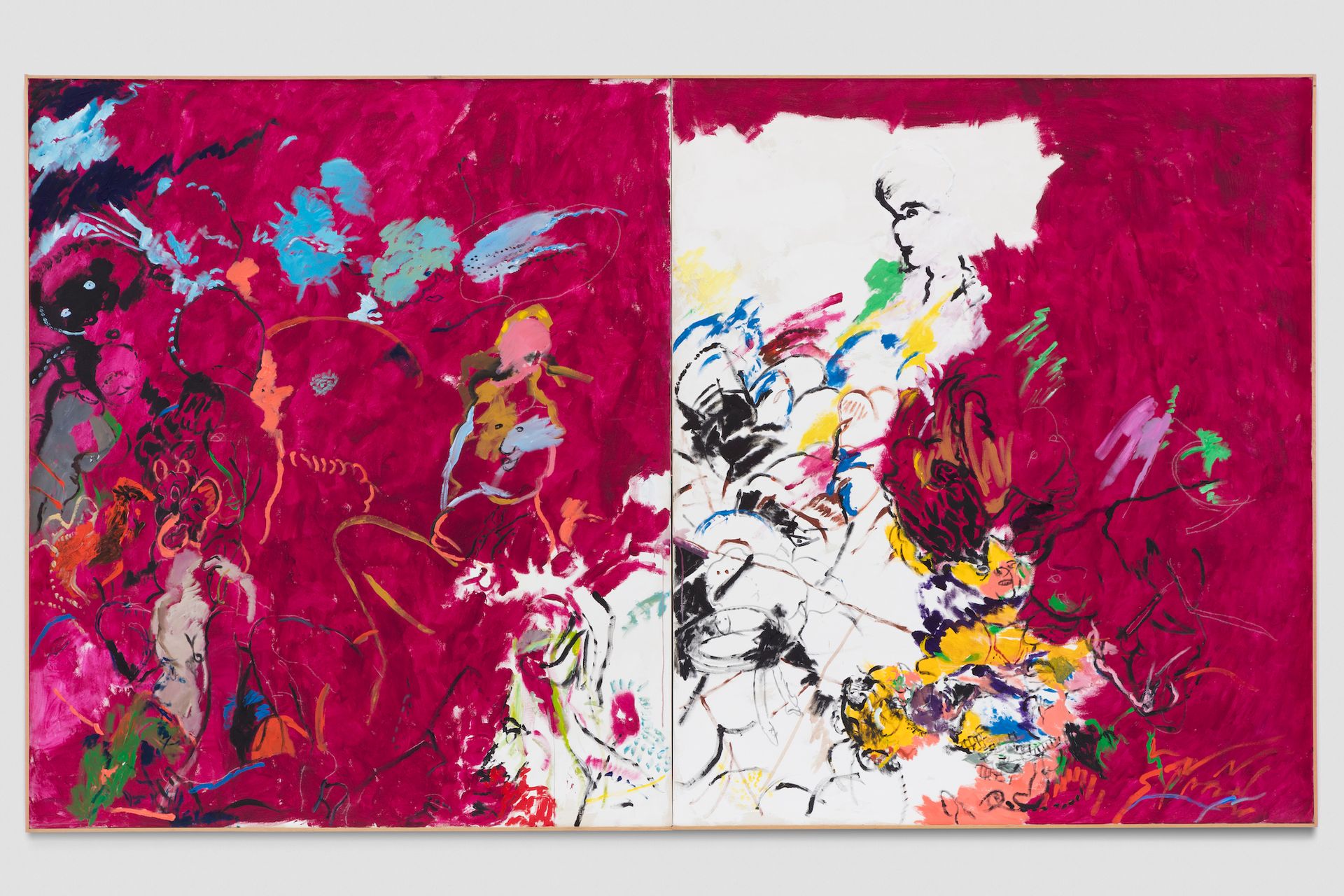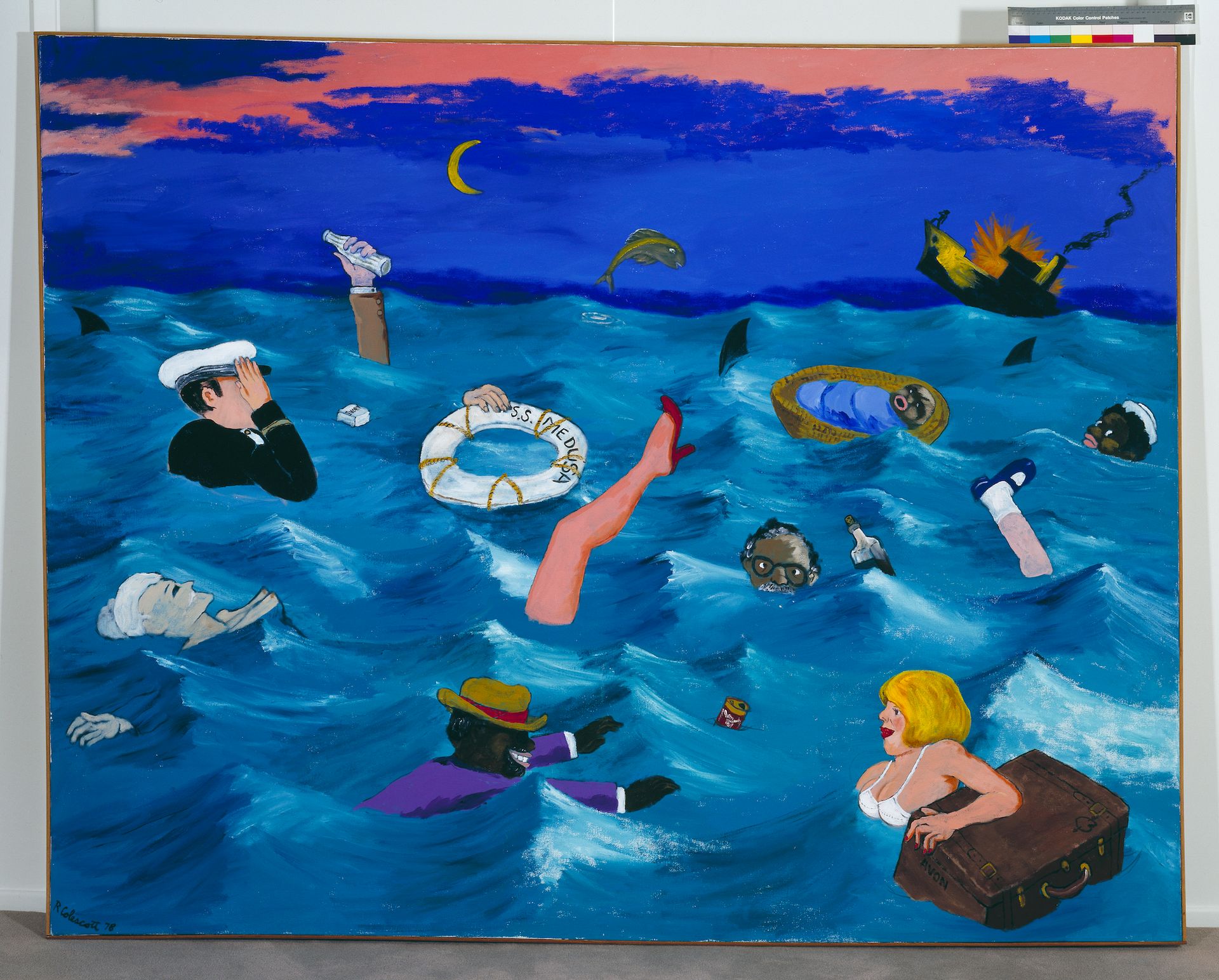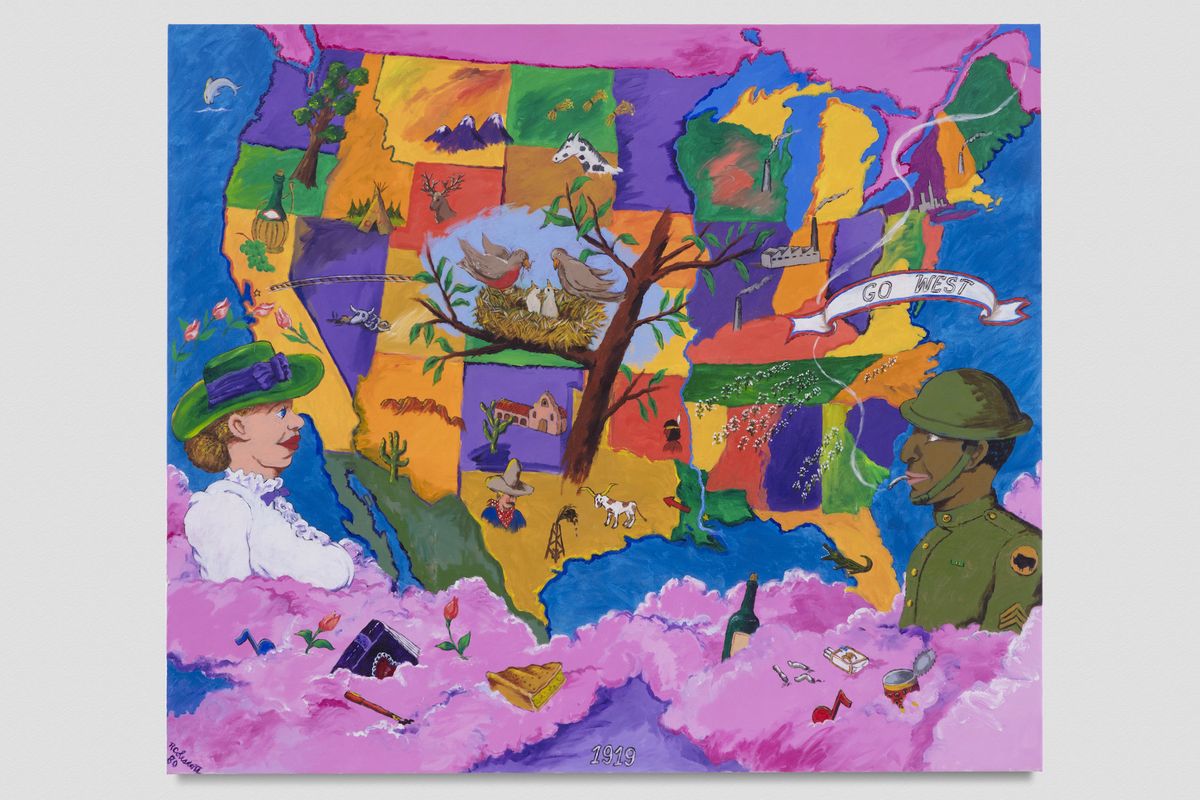Perhaps the best introduction to Robert Colescott’s work comes from the artist himself. In his 1976 video Dulacrow’s Masterwork: A Mockumentary Film, on view at the entrance to Art and Race Matters: The Career of Robert Colescott at the Chicago Cultural Center (until 29 May), Colescott narrates the supposed rediscovery of his own work, Homage to Delacroix: Liberty Leading the People, a sendup of Eugène Delacroix’s famous painting.
A takedown of art historical over-analysis, the slide lecture details how the painting was purportedly forgotten in a chicken coop for more than a century before reintroducing the forgotten master behind it, “Eugene Dulacrow”, played by Colescott. After discussing how Delacroix copied Dulacrow’s original during a boozy studio visit, the narrator moves on to a close reading of the painting itself, from repeated, awkwardly long closeups of Liberty’s bare breasts (“and now it’s time to turn to a discussion of chiaroscuro”), to an investigation of the stretcher bars (“I think we can say that Eugene Dulacrow was one of the masters of the well-placed screw”).
In typical Colescott style, satire is its own coherent political aim. For the artist, the chaos, violence and absurdity of American social relations writ large were subjects to be tackled with unflinching wit and a technicolor palette.

Installation view of Art and Race Matters: The Career of Robert Colescott at the Chicago Cultural Center Photo by James Prinz Photography, Chicago
“For a long time, outside of a small group of devotees in the art world, including the curators, museum directors and writers who have engaged with his work, there was guarded enthusiasm and even outright antagonism towards it,” says Lowery Stokes Sims, co-curator of the exhibition. “What we might have missed is Bob’s satirical approach, which was not about celebrating or justifying such attitudes but was about challenging us to confront our own prejudices and thoughts about humanity and respect.”
Art and Race Matters is the first major retrospective of the painter’s work, co-organized by the Contemporary Arts Center in Cincinnati (it will travel to the New Museum in New York in June). The exhibition, which brings together 55 paintings and works on paper spanning the late 1940s to 2002, includes many of the works from the 1970s and 80s for which Colescott remains best known. These complicated, teeming compositions are a pastiche of racist tropes, Christian iconography, sexualized, pinup-style women, and references to canonical Western painting and contemporaneous events.
Colescott grew up in Oakland, California, the son of a pianist and a jazz violinist from New Orleans. After graduating from high school, he enlisted in the army and served in the Second World War; when he returned to the US, he earned bachelor’s and master’s degrees in art from the University of California, Berkeley, then spent much of his career teaching art in the Pacific Northwest and later at the University of Arizona. Colescott was the first Black artist to have his work featured on the cover of Artforum (in 1984), as well as the first to represent the US at the Venice Biennale (in 1997). He died in 2009 at his home in Tucson, Arizona, of Parkinsonian syndrome.

Robert Colescott, Untitled, 2002 © 2021 The Robert H. Colescott Separate Property Trust / Artists Rights Society (ARS), New York. Courtesy of The Robert H. Colescott Separate Property Trust and Blum & Poe, Los Angeles/New York/Tokyo. Photo Credit: Joshua White
The influence of Bay Area painting shows up in his earlier works, which include abstract compositions, quiet interior scenes and landscapes. Compared to his mature works, the colour palette is drab and there are no signs of, say, phallic cigarettes, gartered legs or characters in blackface. But the looseness in his hand and his interest in reworking canonical painting is clearly visible. In Olympia (around 1959), Colescott reframes the figures in Manet’s famous painting so that they seem to be in dialogue, and as though the Black maid is bringing flowers to the reclining nude, rather than receiving them.
In 1964, Colescott received a grant to conduct research in Cairo, where he lived for two years. The use of narrative in traditional Egyptian art proved influential to the emergence of his mature style and formative in how he located his own racial identity. According to research conducted by art historian Matthew Weseley, who co-curated the show with Sims, Colescott spent the first half of life passing as white. It wasn’t until he lived in Egypt, when he was in his forties, that he identified as Black and took up race as a primary subject in his painting.

Robert Colescott, The Wreckage of the Medusa, 1978 © 2021 The Robert H. Colescott Separate Property Trust / Artists Rights Society (ARS), New York. Private Collection. Photo Credit: Ray Litman
Elsewhere, Colescott, who in addition to his artistic training in the Bay Area had spent a year in Paris studying with French modernist Fernand Léger and making frequent trips to the Louvre, played with art historical references more obliquely. His The Wreckage of the Medusa (1978) references Théodore Géricault’s The Raft of the Medusa (1818-19), but bears little formal resemblance to it. In Colescott’s version the ocean is adrift with various legs, a bar of soap, a caricatured, hypersexualised Black man lunging toward a buxom blonde, and the artist himself—slightly cross-eyed, but still afloat. Unlike many of his other paintings, whose compositions are built up from intersecting bodies and planes, here the miscellaneous fragments of the wreck are distributed evenly against the ocean’s blue ground.
There may be nothing idealistic about the artist’s images, but there is a palpable impish delight that animates both the sensuous qualities of the paint itself and the entropy of his scenes. The ship may be sinking, but Colescott, at least, was primed to go down with a paintbrush in one hand and a drink in the other.
- Art and Race Matters: The Career of Robert Colescott, until 29 May, Chicago Cultural Center.


